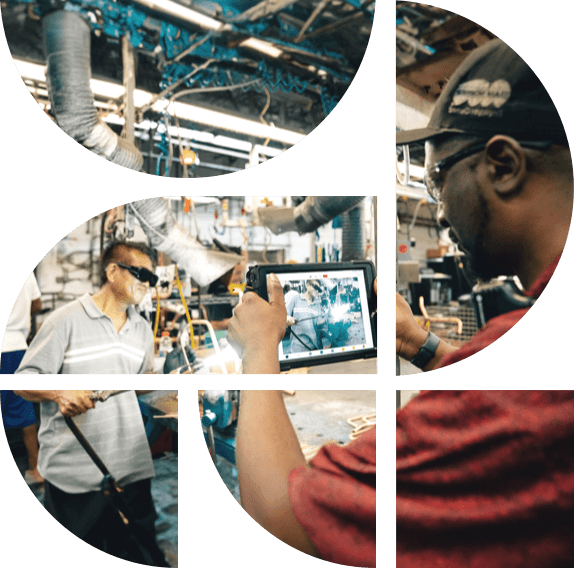Unlock the Secrets to Increased Productivity with Redzone's Newly Released Benchmark Report! Download Today
John Ponte
March 21, 2025

Delivering high-quality products and services is key to success. But quality comes at a cost- so understanding the Cost of Quality (COQ) is essential for any business wanting to be more efficient and profitable. We’ll explore the core concepts of COQ, how it’s measured and managed, and how optimizing it can significantly improve your business performance. We’ll also explore vital concepts like the Voice of the Customer, Brand Equity, and Preventive Maintenance and demonstrate how they intertwine with COQ.
To effectively manage quality, you should learn about its associated costs.
The Cost of Quality (COQ) encompasses all expenditures related to achieving and maintaining product or service quality. It’s a holistic measure that accounts for both the investments made to prevent defects and the consequences of poor quality. By assessing COQ, businesses can evaluate the efficiency and effectiveness of their quality management systems.
COQ is typically divided into four key components:
Customer feedback is invaluable in shaping quality standards and reducing COQ. By actively listening to the Voice of the Customer, you can align your products and services with their expectations, ultimately reducing external failure costs and fostering customer satisfaction. By leveraging effective frontline collaboration, companies can respond and adjust based on customer feedback – reducing external failure costs and improving customer satisfaction.
Measuring the COQ is an efficient way to visualize its impact on your business.
Accurate measurement of productivity metrics, as discussed in our productivity solutions, is essential to gauge of the impact of quality initiatives on overall business performance. Several key metrics help evaluate the effectiveness of your quality systems, including:
COQ data should be used strategically to drive improvement. This includes:
he expanded COQ equation provides a comprehensive view of quality costs and helps organizations balance investments in quality against the potential costs of failures.:
COQ = (Prevention Cost + Appraisal Cost) + (Internal Failure Cost + External Failure Cost)
It’s important to understand that the relationship between COQ and quality investment is not linear. Investing heavily in prevention and appraisal doesn’t necessarily increase total quality costs. In fact, strategic investments in these areas often lead to significant reductions in internal and external failure costs, resulting in overall cost savings.
Prevention costs are proactive investments that aim to prevent defects and ensure quality from the outset.
A QMS is a formalized system that documents processes, procedures, and responsibilities for achieving quality policies. It acts as a roadmap, guiding everyone in the organization toward a shared understanding of quality standards and how to achieve them. This standardization of processes ensures consistency and efficiency, reduces errors, and promotes compliance with industry regulations. Moreover, a good QMS fosters a culture of continuous improvement by providing a framework for identifying areas where processes can be refined and optimized.
Preventive maintenance is all about taking care of your equipment before problems arise. By investing in preventive maintenance, manufacturers can extend the lifespan of their assets, reduce the likelihood of unexpected failures, and avoid the associated downtime and repair costs. A well-executed preventive maintenance program not only saves money but also ensures consistent production output and minimizes the risk of producing defective products due to faulty equipment. This, in turn, contributes to a significant improvement in the overall Cost of Quality.
Appraisal costs are essential for monitoring and measuring quality throughout the production process.
Regular quality audits are a systematic examination of your operations to ensure they comply with industry standards, internal quality protocols, and customer requirements. . By conducting regular quality audits, you can identify potential problems early on, such as deviations from procedures, inefficient workflows, or outdated equipment. This allows you to use corrective action and compliance solutions before these issues escalate and lead to costly external failures like product recalls or customer complaints.
Supplier assessments are equally important for maintaining high-quality standards. After all, the quality of your products depends heavily on the quality of the materials and components you source from suppliers. Evaluating your suppliers’ capabilities, processes, and quality management systems helps ensure they meet your standards and can consistently deliver reliable inputs. Effective supplier assessments can reduce both appraisal costs (by minimizing the need for excessive incoming inspections) and external failure costs (by preventing defects caused by substandard materials). This might involve visiting supplier facilities, reviewing their quality certifications, and conducting sample inspections.
Internal failure happens when defects are identified before products reach customers.
Machine breakdowns are a major headache for manufacturers, impacting COQ in multiple ways. When a vital piece of equipment goes down, it triggers unplanned downtime, halting production and leading to lost output. This downtime also incurs repair costs, as technicians work to diagnose and fix the problem. Furthermore, machine breakdowns can result in product defects, either due to the malfunctioning equipment itself or the rush to get production back online. However, there’s a proactive solution: predictive maintenance. By using data and sensors to monitor equipment health, manufacturers can anticipate potential failures and schedule maintenance before a breakdown occurs.
When internal failures do happen, thorough failure analysis is essential. This involves not just identifying what went wrong, but digging deeper to uncover the root cause. Why did the machine break down? Was it due to wear and tear, improper operation, lack of maintenance, or a design flaw? By understanding the root cause, manufacturers can develop effective corrective action plans to prevent similar failures in the future. This might involve anything from adjusting maintenance schedules and operator training to redesigning a component or upgrading equipment.
External failure costs are the most damaging, both financially and reputationally, as they occur when defective products reach customers.
Warranty costs are a direct financial hit caused by product defects that reach your customers. These costs pile up quickly and include expenses related to repairing or replacing faulty products, shipping and handling those returns, and the administrative overhead of processing warranty claims. A high volume of warranty claims is a warning sign, pointing to potential problems like design flaws, manufacturing errors, poor materials, or inadequate testing.
Analyzing warranty data can help manufacturers identify these issues, take corrective action, and ultimately reduce future warranty costs. For example, a car manufacturer might face massive warranty costs due to a recall for a faulty braking system, while an electronics company might see a surge in claims for a specific smartphone model with a defective battery.
Beyond the warranty period, there are also service and repair costs to consider. These occur when products need fixing after the warranty expires and can involve expenses like paying technicians, sourcing replacement parts, and providing customer support. High service and repair costs drag down customer satisfaction and tarnish brand reputation, as customers get frustrated with the inconvenience and expense. Imagine a homeowner dealing with a broken refrigerator outside of its warranty period or a business facing downtime due to faulty equipment. By proactively addressing quality issues and minimizing the need for repairs, companies can boost customer happiness, build loyalty, and safeguard their brand.
COQ has a profound impact on brand equity, influencing customer perception and long-term brand value.
Consistent product quality is the cornerstone of customer trust. When customers consistently receive products that meet or exceed their expectations, they develop confidence in your brand. This translates to loyalty, repeat purchases, and positive word-of-mouth referrals. Effective COQ management plays a crucial role in this process. By proactively preventing defects and efficiently addressing any quality issues that arise, you demonstrate a commitment to customer satisfaction.
Brand value is a precious asset, built over time through consistent quality, positive customer experiences, and a strong reputation. Maintaining high-quality standards is essential for protecting and enhancing this value. By prioritizing quality and effectively managing COQ, you send a clear message to your customers: you care about their experience and are committed to delivering excellence. This fosters long-term loyalty, drives repeat business, and strengthens your brand’s position in the market.
Understanding and measuring the cost of quality is just the first step. Let’s review some real-life examples showcasing the successful implementation of COQ strategies.
Marianna Beauty, a leading cosmetics manufacturer, struggled with inefficient production and low employee morale. Their traditional management style hindered communication and collaboration, directly impacting quality and output. To address these challenges, they partnered with Redzone and implemented their real-time production efficiency software. This wasn’t just a technology upgrade; it was a complete overhaul of their work cell, empowering frontline workers with a voice and a platform for problem-solving. Redzone’s software provided instant visibility into production performance, enabling rapid response to issues and data-driven decision-making.
The results were transformative. Marianna Beauty saw a 20% productivity boost in the first year, significant cost reductions from less waste and downtime, and a marked improvement in product quality. More importantly, employees felt heard and valued, leading to increased engagement, higher morale, and lower turnover. The company culture shifted from a top-down hierarchy to a collaborative and empowered workforce, all thanks to Redzone’s focus on real-time data, open communication, and employee engagement. This case study perfectly illustrates how strategic quality management, combined with a positive cultural shift, can dramatically improve both cost efficiency and overall business performance.
The Cost of Quality typically represents 15-40% of total business costs. Benchmarking your COQ against this range can help you assess your performance and identify areas for improvement.
The Cost of Quality is far more than just a number; it’s a critical factor that influences every aspect of your business, from your bottom line to your brand reputation. By understanding and actively managing COQ, you can unlock significant improvements in efficiency, productivity, and customer satisfaction. Investing in prevention and appraisal activities might seem like an upfront expense, but it’s a strategic move that pays dividends by minimizing costly internal and external failures.
Remember that quality is a journey, not a destination. Continuous monitoring and improvement of your COQ strategy are essential for optimizing costs and ensuring long-term success. Embrace a culture of quality, empower your workforce, and leverage the power of real-time data to drive meaningful change.Ready to take control of your Cost of Quality and elevate your business performance? Contact us today to learn how Redzone can help you optimize your quality management strategy.
John Ponte John is QAD Redzone’s Senior Director of Growth Marketing and brings a background of over 20 years in B2B Software. He is responsible for setting the growth strategy and driving global demand generation strategies to boost pipeline, new customer acquisition, and create expansion opportunities. When John’s not tracking Marketing and business targets, you can find him playing tennis, and even officiating as a national umpire and referee, working with local charities he supports, and enjoying time with family.
Twice the Frontline Engagement: Priceless A spring in the step, a smil...

Contact us and let's begin empowering your frontline and growing your bottomline.
